Solving Quadratic Equations by Factoring
and Extracting Roots
Recall that at the end of chapter 4 we discussed solving
polynomial equations. We want to expand upon one particular type of polynomial
equation called the quadratic equation.
Definition: Quadratic Equation
A quadratic equation is an equation of the form
 . When the equation is written with all terms
on one side and zero on the other, the equation is in standard form.
. When the equation is written with all terms
on one side and zero on the other, the equation is in standard form.
We want to be able to solve all possible quadratic
equations. The first method we can use is the method that we learned in chapter
4. That is, by factoring.
In order to solve by factoring we need the following
property.
The Zero Product Property
If  then
then
 or
or 
Example 1:
Solve the following equations by factoring.

Solution:
a. We first begin by factoring completely. Recall the first step in factoring is
factor out the GCF. Then by the zero product property we set each factor to zero
and solve. So we get
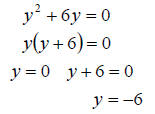
So the solution set is 
b. In order to solve a quadratic by factoring we first
need it in standard form. So we will begin by moving the 9 to get a zero on the
one side. Then factor and set each factor to zero. We get
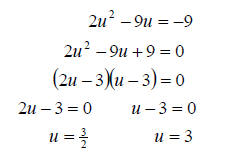
So the solution set is 
c. Again we need to start by getting the equation into
standard form. That means we need to multiply out the parenthesis and move
everything to one side. Then we solve by factoring as before.
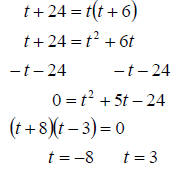
So the solution set is 
We don’t only want to solve quadratic equations but we
also want to be able to get the equation based upon its solutions.
To do so we notice the following: If we solve the equation
 we get the solutions of
we get the solutions of

So this tells us that if we start with two solutions, we
can simply plug them back into the formula  to generate the equation.
to generate the equation.
Example 2:
Write the equation in standard form with integer
coefficients that has solutions of the following

Solution:
a. We start by labeling  Now we insert them
into the formula and multiply out to get
Now we insert them
into the formula and multiply out to get
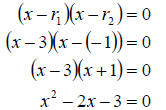
So the equation is  .
.
b. Again we label  We
insert them into the formula and multiply as before to get
We
insert them into the formula and multiply as before to get
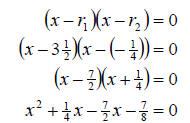
At this point we recall we wanted integer coefficients.
Therefore we must clear the fractions. We choose to do this now since it is
easier to combine like terms after we clear the fractions. So we multiply both
sides by the LCD of 8 and continue

So the equation is  .
.
Everything we have done in this section is great, however,
we know that not everything factors. So we want to start to build the tools for
solving all quadratic equations. The first of these tools is called extracting
roots and only works when a quadratic equation is in a very particular form.
First consider the equation
 . Solving by factoring we get
. Solving by factoring we get
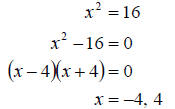
In order to simplify the two answers into one single
expression we simply write

So from this we can see the following
Principle of Extracting Roots
If  then
then

So what this property states is, when we have a squared
expression on one side of the equation, we can “square root” both sides to
simplify. We simply need to remember to put the
 in front of the numerical side to show that
we have two possible answers.
in front of the numerical side to show that
we have two possible answers.
The real reason for the  symbol goes back to the property that states
symbol goes back to the property that states  For simplicity we omitted the absolute value however, knowing how to solve
absolute value equations we would really get
For simplicity we omitted the absolute value however, knowing how to solve
absolute value equations we would really get
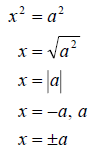
Whichever way you choose to remember it, (either as just a
rule or as the absolute value) just make sure that the
 is used.
is used.
Example 3:
Solve the following.

Solution:
a. Since factoring can clearly not solve this equation we will apply the
principle of extracting roots. To do this we must first get the x^2 isolated on
one side. We then “take the square root of both sides” and attach the
 symbol.
symbol.
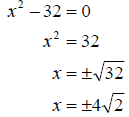
So the solution set is 
b. Again we need to extract the roots to solve. First we
need to isolate the portion of the equation which is squared. Then we extract
the roots as follows
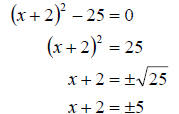
We still need to completely isolate the variable x so we
have

Now, recall the ± represents two possible cases, + and -.
So since we can actually calculate –2 + 5 and –2 - 5 we need to split the ±
symbol up and finish calculating the solutions. We have

So the solution set is 
c. Finally, we again use extracting roots to solve.
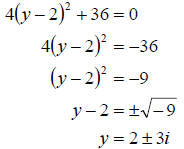
Recall, 
So we have two complex number solutions. The solution set
is 
10.1 Exercises
Solve the following equations by factoring.

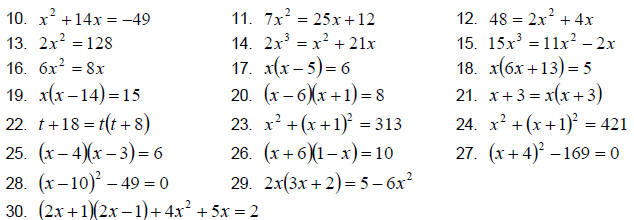
Write the equation in standard form with integer
coefficients that has solutions of the following.

Solve the following.
